In China, production of food-fish weighing between 0.5 and 1.5 kg, is traditionally carried out using fingerlings which have been raised in a fattening pond for several months. Depending on the temperature and fertility of the waters of the region under consideration, the complete production cycle (from egg to table fish) takes 2–3 years. It may exceptionally take one year in the hottest and most fertile southern regions.
The most widely used farming system is polyculture, using complementary species, organic fertilizing of the waters and supplementary feeding. This is why it is defined as ‘semi-intensive’, by opposition to the intensive system based essentially on artificial feeding of fish reared in ponds (Section 7) and the extensive system which is based on natural feeding (Sections 8, 9 and 10).
Not only is this system well-suited to the species used, but it also fits in with the current policy of integrated development of plant and animal production and self-sufficiency in food, which is being pursued in the rural areas of China. Historically, the fundamental principles of management of this semi-intensive system have been known since the Fifteenth Century (Table 10), but it is only recently, since 1960, that it has been possible to apply them on a large scale (Section 2.6).
Polyculture of Chinese fish species rests on three principles:
taking advantage of mutual benefits while avoiding competition for food. Several different species are therefore reared together in the fattening pond. Depending on the type of food available locally, one or two of the main species of Chinese carps are chosen: silver, bighead, grass, black or mud. They are then combined with complementary secondary species on the basis of the principles set out above and the ecological requirements of the species considered (Table 17), e.g.:
During the study tour, several examples of polyculture were able to be identified in addition to those mentioned in the literature (Table 22). They are a good illustration of how fish combinations vary according to region. The mud carp is confined to a hot subtropical climate, while there are more black mollusc-feeding carps as we approach the lakes, i.e., in the Jiangsu province. The total number of species used in polyculture generally varies between four and eight, although the current trend is to increase the number.
Table 22
Fish combinations used in polyculture
(tN = total number of fish; tW = total weight of fish)
| Fish species | Guangdong | Hunan | Hubei | Jiangsu | |||
| Leliu People's Commune % tN | Delta % tW | Linfu State Farm % tW | Shihu PC % tW | Baitanhu State Farm % tW | Hele PC % tW | Holi PC % tW | |
| Silver carp | 3.5 | 7.8 | 45 | 58.6 | 60 | 30.7 | 38.5 |
| Bighead carp | 5.8 | 47.3 | 20 | 17.8 | 15 | 9.5 | 7.0 |
| Grass carp | 9.3 | 18.8 | 20 | 11.3 | 20 | 28.4 | 19.6 |
| Mud carp | 81.4 | 18.8 | - | - | - | - | - |
| Black carp | - | 1.6 | - | - | - | 12.4 | 20.0 |
| Common carp | - | 1.6 | 5 | 3.5 | 3 | 3.0 | 5.0 |
| Wuchang bream | - | 1.0 | - | - | - | 10.0 | 8.5 |
| Crucian carp | - | - | - | - | 2 | 2.0 | 0.6 |
| Tilapia | - | 3.1 | - | - | - | 4.0 | 0.8 |
| Miscellaneous | - | - | 10 | 8.8 | - | - | - |
| Reference | pers. comm. | Anon., 1980 | ADCP, 1979 | pers. comm. | pers. comm. | ADCP, 1979 | |
Ideally, we consider that the total stocking rate in a fattening pond under natural conditions should never exceed 6 000–6 750 kg/ha, so that the rates of dissolved oxygen may be sufficiently high and to ensure adequate rates of growth (Anon., 1980).
Where the four family carps are concerned, there are also specific stocking rates which should not be exceeded in polyculture (Table 23).
Table 23
Maximum specific stocking rates in polyculture
(adapted from Anon., 1980)
| Species of Chinese carp | Initial maximum stocking rate (kg/ha) | Final maximum stocking rate (kg/ha) |
| Mud | 660–1 200 | 1 875–2 400 |
| Grass | 480–750 | 1 350–1 500 |
| Bighead | 150–300 | 450–600 |
| Silver | 105–195 | 300–450 |
The initial stocking density of the pond, expressed in number of individuals of each species per unit of surface, is calculated by dividing the final maximum stocking rate per species by the final unit size required for marketing. This size varies according to the region and the species. In the province of Guangdong, for example, the silver, bighead and grass carps are sold when they reach a size of 1–1.5 kg, while in the province of Hubei, a size of 0.5–1 kg suffices. On the other hand, mud carps are eaten at 125–250 g. Therefore, if we wish to produce bighead carps each weighing 1 kg, stocking density should not exceed 600 kg/ha divided by 1 kg, i.e., 600 individuals/ha. This density may be doubled if the final size of the fish is reduced to 0.5 kg. We could also allow for the rate of mortality expected during rearing (e.g., 5 percent) and thus correct the stocking density calculated above accordingly.
Traditionally, Chinese carps for consumption are produced from fingerlings which have been reared in separate age groups, by polyculture (separate age method). The complete rearing cycle in ponds therefore comprises three successive stages, two fry/fingerling raising stages (Section 5) and one fattening stage. During the latter stage, fry of the same age class, of the species chosen, are raised together in the same pond.
One to three of these species are considered the main species and the others, secondary. The species to be farmed are chosen according to the principles of polyculture (Section 6.1.1), but also according to:
Therefore:
In sub-tropical zones the main species are usually bighead, mud and grass carps. A practical example of this type of fish farming can be seen in the Zhu Jiang delta region, Guangdong (Table 24).
The traditional method has been improved in recent years. At the present time,two main types of improved polyculture are practised:
(a) The chief aim of improved polyculture using mixed age classes (locally termed ‘rotational harvesting and stocking’) is to maintain the specific stocking rates at their optimum level throughout the rearing period. To achieve this, a sufficient number of fingerlings of the chosen species and from different age classes are initially stocked in the growing pond. After a few months of growth, the specimens which have reached marketable size are harvested and replaced by other fingerlings. The frequency with which harvesting and stocking takes place differs according to species, initial sizes, marketable sizes, feed distribution, etc. Generally speaking however, this method allows one or two harvests to be carried out annually for mud, common and black carps (species which exhibit slow growth), two harvests for grass and silver carps and up to five or six for bighead carps. This is why the multiple age method has developed so rapidly.
Two examples of this method were seen during the visit to the ‘October’ Production Brigade, district of Xishui (Hubei). Two ponds have been set up in a former river bed and polyculture is practised using seven species, with the grass carp as the main one. Large fingerlings (grass carps 500 g and others 100 g each) are stocked twice a year, in January and July. The more fertile of the two ponds (0.47 ha), which is stocked at a high density of 8 300 fingerling/ha/stocking operation, well fertilized and supplied with food (aquatic grasses), produced two harvests totalling 7 450 kg/ha in 1979. The second pond (4 ha), which was stocked only twice at the rate of 3 225 fingerlings/ha each time, produced two harvests totalling 4 100 kg/ha of food-fish during the same year.
Table 24
Traditional polyculture by separate age classes, in the region of the Zhu Jiang Delta, Guangdong
(adapted from Anon., 1980, page 84)
| Species | Stocking | Harvest | Mortality (%) | Production | ||||||
| Size (g) | Density specimens/ha | Stocking rate kg/ha | % tW | Size (g) | Density specimens/ha | Stocking rate kg/ha | kg/ha | total % | ||
| Bighead carp | 500 | 2 250 | 1 125 | 47.0 | 1 000– 1 500 | 2 175 | 2 715 | 3.3 | 1 590 | 27.2 |
| Mud carp | 25–50 | 14 000 | 450 | 18.8 | 120–160 | 13 050 | 1 958 | 6.8 | 1 508 | 25.8 |
| Grass carp | 250 | 1 800 | 450 | 18.8 | 1000– 1 500 | 1 440 | 1 815 | 20 | 1 365 | 23.3 |
| Silver carp | 250 | 750 | 187 | 7.8 | 1 000 | 705 | 705 | 6 | 517.0 | 8.8 |
| Tilapia | 15–20 | 4 000 | 75 | 3.1 | 150 | 3 750 | 562.5 | 6.2 | 487.5 | 8.3 |
| Common carp | 100 | 375 | 37.5 | 1.6 | 900 | 300 | 270 | 20 | 232.5 | 4.0 |
| Black carp | 500 | 75 | 37.5 | 1.6 | 2 000 | 60 | 120 | 20 | 82.5 | 1.4 |
| Wuchang bream | 50 | 525 | 30 | 1.3 | 250 | 375 | 97.5 | 28.6 | 67.5 | 1.2 |
| Total | 23 775 | 2 392 | 100 | 21 855 | 8 243 | 8.1 | 5 851 | 100 | ||
More detailed data is obtainable for an experimental pond (0.48 ha) in the Wuxi region, Jiangsu (ADCP, 1979), where improved polyculture by mixed age classes was already being practised at a relatively intensive level in 1977 (Table 25). Fingerling of different age classes, belonging to eight different species (mainly silver, grass and black carps) were first stocked in January. It was therefore possible to carry out a first selective harvest in June-September of grass carps (over 1 kg in weight), silver and black carps (over 500 g). Further stocking was done in May (crucian carps and tilapia), end of June (common carp) and August (silver and bighead carps), as the ponds warmed up and the carp harvest was intensified. Feed and fertilizer were applied frequently and artificial aeration of the water was often used. The final harvest took place at the end of the year, and the fish which had not reached marketable size were used for the new rearing cycle. This method therefore allowed very high densities and stocking rates to be used initially, e.g., in January, 38 595 specimens/ha, i.e., almost 5 500 kg/ha. Six to eight months later, after the first large specimens had been harvested, a large number of small fingerlings were stocked. At the end of the year, the pond had produced 16 t/ha, which corresponded to a yield of 22.8 t/ha. Later trials confirmed these results.
Table 25
Improved polyculture by mixed age classes: Holi People's Commune, near Wuxi, Jiangsu
(adapted from ADCP, 1979)
| Species | Stocking | Total harvest (kg/ha) | Production | |||||
| Month | Average weighta (g) | Density (specimens/ha)a | Rate (kg/ha)a | % tW | kg/ha | total % | ||
| Silver carp | Jan. | 215 | 2 655 | (2 504) | 38.6 | 7 615b | 4 658b | 28.5b |
| Jan. | 380 | 2 685 | ||||||
| Aug. | 130 | 7 020 | 2 957b | |||||
| Bighead carp | Jan. | 110 | 885 | 6.9 | ||||
| Jan. | 400 | 885 | (453) | |||||
| Aug. | (2) | 945 | ||||||
| Black carp | Jan. | 1 070 | 900 | 1 303 | 20.0 | 3 340 | 2 037 | 12.5 |
| Jan. | 261 | 915 | ||||||
| Jan. | 18 | 4 875 | ||||||
| Grass carp | Jan. | 940 | 945 | 1 284 | 19.6 | 3 353 | 2 069 | 12.7 |
| Jan. | 315 | 1 125 | ||||||
| Jan. | 7 | 6 375 | ||||||
| Common carp | Jan. | 185 | 1 770 | 331 | 5.0 | 1 849 | 1 518 | 9.3 |
| June | (2) | 1 770 | ||||||
| Wuchang bream | Jan. | 46 | 10 410 | 553 | 8.5 | 2 750 | 2 197 | 13.5 |
| Jan. | 17 | 4 170 | ||||||
| Carassin | May | (3) | (12 500) | 37.5 | 0.6 | 1 543 | 1 505 | 9.2 |
| Tilapia | May | 4 | 8 850 | 52.1 | 0.8 | 2 383 | 2 331 | 14.3 |
| July | 2.5 | 6 255 | ||||||
| Total | Jan. | - | 38 595 | 5 498 | - | - | - | - |
| Others | - | 37 340 | 1 020 | - | - | - | - | |
| General | - | - | 6 518 | - | 22 833 | 16 315 | - | |
a Estimated figure is given in brackets
b Total for silver and bighead carps
(b) Improved polyculture using separate age classes (locally termed ‘multigrade conveyor culture’) is a more recent technique which is less widely used than the former. It is particularly popular in the Xi/Zhu Jiang (Guangdong), where it has developed alongside efforts in collective agricultural production (Anon., 1980). It is derived directly from the traditional separate age method, but instead of being limited to two separate rearing periods, four periods are used (multigrade method) which makes it possible for larger fingerlings to be stocked in the growing ponds. The basic principles of polyculture are applied (Section 6.1.1), as well as the principles for determining the maximum stocking rates and densities (Section 6.1.2). The rearing period is shortened, the number of harvests increased and fish of the required marketable size are more easily produced. The disadvantage of this method is that a large number of ponds are required for large-scale fish production. To ensure the success of this improved system of polyculture, it is essential that production stoppages caused by a shortage of any category of fry or fingerling be avoided. The surface areas of the ponds used must therefore be sub-divided according to the needs for growth (generally 65 percent of the total area) and the needs of fry of different sizes (35 percent) which will finally be used to stock the fattening ponds. The multigrade method varies depending on the species reared. As an example, the management plans for three of the main chinese carp species are shown diagramatically in Table 26.
Table 26
Examples of management plans for Chinese carp rearing, using multigrade polyculture
(adapted from Anon., 1980)
| Parameter | Storage ponds | Fry and fingerling ponds | Fattening ponds | ||
| I | II | III | |||
| A. Bighead carp | |||||
| Initial average weight (g) | 10 | 10–30 | 40–90 | 200–250 | 500 |
| Final average weight (g) | 10–30 | 40–90 | 200–250 | 500 | 1 000–1 500 |
| Stocking density/ha | 75 000–90 000 | 6 000 | 2 400 | 1 050 | 330 |
| Period (days) | continuous | 40 | 40 | 40 | 40 |
| Surface, % totala | 1.5 | 3.6 | 8.9 | 20.5 | 65 |
| B. Grass carp | |||||
| Initial average weight (g) | 0.2 | 7–12 | 30–70 | 100–150 | 250–500 |
| Final average weight (g) | 7–12 | 30–70 | 100–150 | 250–500 | 1 300–1 500 |
| Stocking density/ha | 105 000–120 000 | 15 000–19 500 | 6 000–7 500 | 2 250–3 750 | 600–1 200 |
| Period (days) | continuous | 120–180 | 120–180 | 120–180 | 120–180 |
| Surface, % totala | 1.5 | 4 | 9 | 20 | 65 |
| C. Silver carp | |||||
| Initial average weight (g) | 1 | 10 | 40–60 | 250–600 | |
| Final average weight (g) | 10 | 40–60 | 250–600 | 1 000–1 500 | |
| Stocking density/ha | 60 000–75 000 | 3 000–4 500 | 300–510 | 300–600 | |
| Period (days) | continuous | 60–90 | 120–180 | 120–180 | |
| Surface, % totala | 0.5b | 4 | 40.5 | 55 | |
a 0.5 percent of the total surface is used for storing silver carp fry
b In addition to storage surfaces provided for other species
It will be seen that the storage ponds are by definition fry or fingerling ponds (Sections 5.2 and 5.3) (e.g., grass carp) or ponds for early or advanced fingerlings (silver and bighead carps, respectively). When the whole production cycle takes place locally, fry needed for stocking the storage ponds must be produced separately, in other ponds.
Growth rates and yields vary widely depending on the species, the system of farming used and the region. In hot, sub-tropical conditions, with semi-intensive farming, the sizes obtained at the end of the first three years for the three main Chinese carps (Table 27) vary between 1 and 2 kg; 2 and 5 kg, and 4 and 11 kg, respectively. The best growth rate, which can reach an average of 15 g/day, is exhibited by the bighead carp. Grass and silver carps grow more slowly (6–7 g/day). When provided with a mollusc-rich diet, the black carp can also quickly grow to a large size. The mud carp however, grows slowly and is always small.
In more temperate regions, growth rates are not as high. In Shanghai, for example, silver and bighead carps reach 0.5 kg only in the second year, while grass and black carps reach 2.5 kg in the third year. At the Baitan Hu State Farm (Hubei), the main Chinese carps stocked as fingerlings (17 cm) in January–February, reach 0.5–1 kg by the end of the year. Even in temperate regions, however, growth can be relatively fast when the system of farming is intensified (Table 25).
The average annual yield from pond farming at the national level was approximately 2 750 kg/ha in 1979 (Table 8). On the basis of yields observed during the study tour (Table 28), this figure seems rather low. In order to increase yields, current trends include increasing the number of species reared by polyculture, increasing the individual size of the stocking fry, increasing stocking rates and densities, as well as intensifying management, particularly by supplementary feeding and artificial aeration. It has already been shown that in these conditions very high yields and levels of production can be obtained. At the Hele People's Commune, for example, yields approaching 15 t/ha and productions of 12 t/ha were obtained in some ponds in 1979. Production figures continue to vary widely however, and yields are closely related to the experience of the management staff.
Table 27
Growth rates for main Chinese carp species reared in ponds in hot sub-tropical climates
| Species | Normal size (kg) reached at the age of | ||
| 1 year | 2 years | 3 years | |
| Silver carp | 1 | 2–3 | 4–5 |
| Grass carp | 1–2 | 4–5 | 10 |
| Bighead carp | 1–2 | 3–4 | 8–11 |
| Mud carp | (25–50 g) | (120–160 g) | (250–300 g) |
Table 28
Average yield obtained in fattening ponds in 1979
| Location | Pond farminga | 1979 yield | |||
| Area (ha) | Harvest (t) | Average (kg/ha) | Extreme (kg/ha) | ||
| 1. | Beijing, Shuangqiao People's Commune | 80 | 110 | 3 000 | max. 10 500 |
| 2. | Hubei, district of Xishui, ‘October’ Production Brigade | 11.77 | 92.3 | 6 000 | 4 000–8 000 |
| 3. | Jiangsu, Hele People's Commune, Production Team No. 1 | 15.87 | 150 | 9 000+ | 6 000–12 000 |
| 4. | Guangdong, Leliu People's Commune | 2 400 | 7 700 | 3 200 | 1 500–7 500 |
Both mineral and organic fertilizers are used in Chinese fish culture. However, the latter are by far the most commonly used since they favour the development of plant and animal organisms (plankton, benthos, aufwuchs), on which the diets of the microphagic Chinese carps are based.
As regards mineral fertilizers, compound formulae are preferred and in particular, 4N-4P-2K, which is applied at the respective rates of 0.9-0.9-0.45 ppm (Anon., 1980).
The organic fertilizers consist mainly of green manures (tatsao), compost, animal manure and domestic waste water. Direct organic fertilization (e.g., piggeries and latrines on the water), although still used in some southern regions, is currently being replaced in many regions by controlled fertilization, based on prior fermentation. Farm animal droppings, mixed with plant matter and silt, ferment for ten days before being applied to the ponds. This considerably reduces the chances of pathogenic agents being transferred. Human waste matter ferments for four weeks in a closed chamber before being used.
Large quantities of these organic fertilizers are applied (Section 6.2.3) and deoxygenation of the water may result. At the beginning of the hot season and during the rainy season, special attention is paid to this danger, to prevent fish mortality. Reduction of fertilization, increase of freshwater supplies and artificial aeration are the principal measures taken to avoid mortality.
In the semi-intensive system of fish culture, two main types of food (plants and agricultural by-products) are distributed to farm fish in addition to an increased supply of natural food resulting from fertilization of the pond. Compound feeds are still reserved on a priority basis, for intensive farming (Section 7), although they could also be used as feed supplements in the semi-intensive system.
Among the plants which are distributed mainly to the herbivorous species (forage), but which could also have a fertilizing effect (green manure) - we must mention elephant grass (Pennisetum purpureum), various vegetables, fresh rice stalks, leaves and stems of melon and maize and leguminous plants, as well as several aquatic plants, such as the water hyacinth (Eichornia crassipes), Pistia, Wolffia, Lemna and Azolla. Land plants can be cultivated on the dykes which separate the ponds (Section 6.3), especially elephant grass, whose root system protects the soil from erosion and whose quick growth allows it to be cut repeatedly (Figure 35). Large quantities of aquatic plants are cultivated in the shallow ditches, canals and ponds (Figure 33). Water hyacinths produce 400–750 t/ha of plant matter annually. They can be cut into pieces and composted/fermented together with manure and quicklime prior to being applied to the ponds.
There are also many agricultural by-products in use. Depending on the region, these are cakes (soy bean, groundnut, etc.), brans (rice, wheat, barley), cereals (maize, sorghum and barley grains), residues of fermentation (wine, beer, soya), or silkworm pupae (Figure 36).
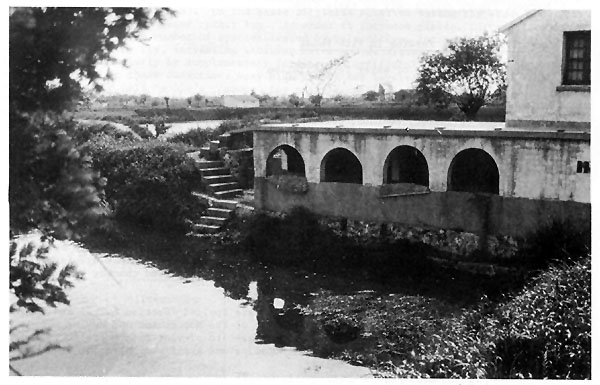
Figure 31 Piggery at the pond's edge. Hele People's Commune, Wuxi, Jiangsu

Figure 32 Duck farm from which the fertilized water is distributed among several fish ponds by means of a system of canals. Hele People's Commune, Jiangsu
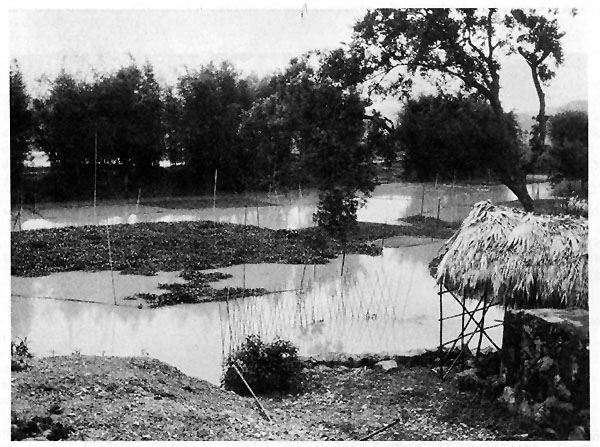
Figure 33 Cultivating Eichornia crassipes and Azolla imbricata for animal feeding. Leliu People's Commune, Guangdong

Figure 34 Feeding grass carps with residue from vegetable crops. ‘October’ Production Brigade, Xishui, Hubei
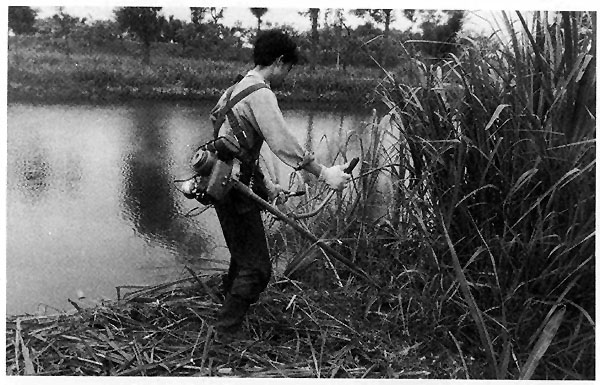
Figure 35 Cutting elephant grass cultivated on the dykes of the ponds as food for grass carp (Photo F. Botts)
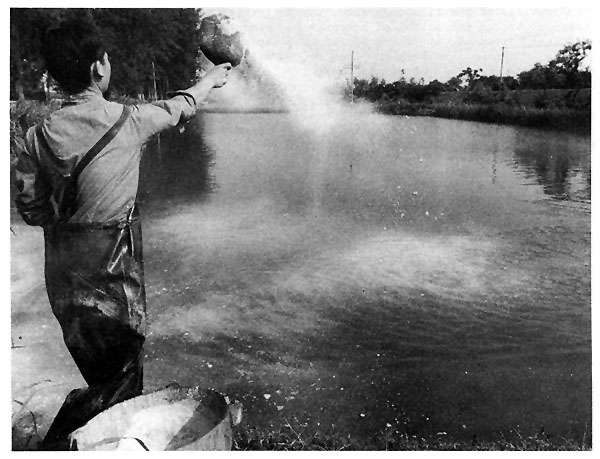
Figure 36 Casting the daily ration of agricultural by-products (Photo F. Botts)
It is practically impossible to dissociate fertilization and supplementary feeding in semi-intensive Chinese aquaculture, since they together provide nourishment for the fish during both their rearing and fattening periods. Where organic fertilizers are available, they can be used in large quantities, as the few examples provided during the study tour show (Table 29). The food that is distributed serves either to complete the natural diets of the planktonivorous species, or to feed the grass and molluse-eating species directly.
As stated above (Section 6.1.1), species for cultivation are chosen on the basis of the main types of food available locally. More widespread use of compound feeds (Section 7.1) should also give fish culturists a freer hand in the future, since grass and black carps could then be cultivated when large quantities of forage or molluses are not available. In this context, it must be recalled that a grass carp weighing 1 kg consumes an equal quantity of plant matter daily.
The rates of transformation into fish of the various fertilizers and foods, quoted by the technicians of Hele People's Commune (Jiangsu) were as follows:
Also, the quantity of each feed supplement required to produce 1 kg of grass carp is approximately the following (Anon., 1980): young land forage - 35 kg; aquatic forage: Wolffia - 37 kg, Lemna - 40.6 kg or Vallisneria - 101 kg; silkworm pupae - 1.8 kg; soy bean cake - 4 kg; rice bran - 6.8 kg.
The droppings of the fish themselves may be integrated into the production cycle of other species through the action of bacteria and planktonic organisms. At the Hele Fish Culture Centre (Jiangsu), it is considered that the droppings produced by the black or common carp during the time it takes them to increase their weight by 1 kg, can produce 0.6 kg of bighead or silver carp. Another example of this type of organic recycling was observed at the Fish Culture Centre of the Qingshan Reservoir (Zhejiang), where grass carps are reared intensively in cement ponds (Section 7.2). Downstream from these ponds, silver and bighead carps are reared in a cement-lined channel, using the droppings of grass carps (Figure 37). A biomass of 100 kg of these droppings suffices for the extensive rearing of 10 kg of planktivorous carps.
Table 29
Quantities of organic fertilizer and feeds used annually for fish production in ponds
| Location | Fish production | Organic manure | Plant matter | Various products | |
| Leliu People's Commune, Guangdong | 2 400 ha | 50 000 t | 154 000 t | 5 400 t | |
| 7 700 t | (silkworms, pigs, etc.) | (elephant grass) | (soy bean cake and brans) | ||
| + 140 million fry | |||||
| Hele People's Commune, Jiangsu | harvest: | 246 t/ha | 136.5 t/ha | - | molluscs: 45 t/ha |
| 11 895 kg/ha | - | agri. prod. | |||
| output: 8 880 kg/ha | (barley): 3 975 kg/ha | ||||
| Others (Zhu De-Shan, 1980) | 300–375 t/ha | 105–150 t/haa (aquatic plants) | - | molluscs: 75–112 t/ha | |
| - | agri. prod. 1 500–2 250 kg/ha | ||||
Fertilization and feeding are used in such a way that the principle ‘even, good and sufficient’ may be respected. In practice, this results in the ‘four fixes’ method; fixed quality and quantity of feeds, fixed time and site of feeding (Zhu De-Shan, 1980).
For each pond the daily quantities of fertilizer and feed to be distributed are determined by the water temperature, the dissolved oxygen content, the amount of plankton in the water and the feeding performance of the fish. The technician therefore uses the method of the ‘four observations’, i.e., observation of the season, climate, water colour and fish.
Integration of fish culture with agriculture and the other forms of farming is widespread in the people's communes and State farms (Section 6.3). Not only does this enable a reasonable amount of the manure and feed required to be produced on the spot (e.g., on the dykes), but it also allows all agricultural and pond by-products and residues to be completely utilized. At the same time, the number of harvests increase (catch-crop growing, mixed cultivation, etc.), so that the fish can be fed all year round, and the secondary water surfaces are used to produce the aquatic plants required.
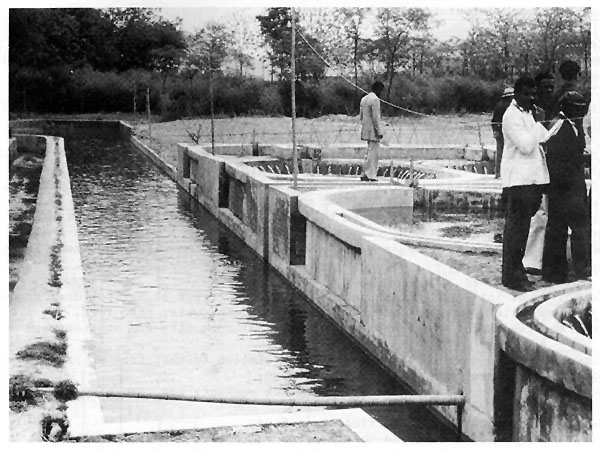
Figure 37 Cement-lined channel located downstream from farm where grass carps are reared intensively, used for integrated farming of silver and bighead carps. Qingshan Reservoir Fish Culture Centre, Zhejiang
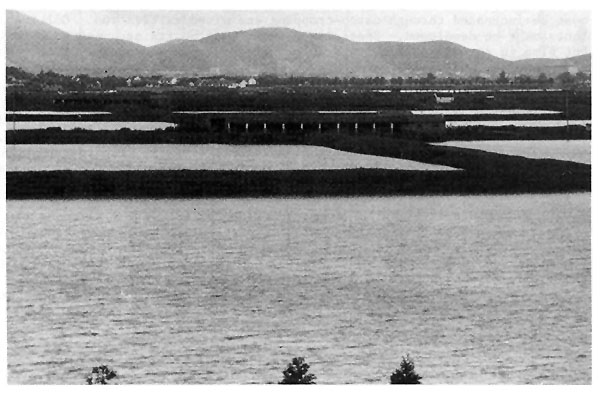
Figure 38 Piggeries integrated with the fish culture ponds at the Hele People's Commune, Jiangsu
Integrated rural development has been a traditional Chinese practice for many years. Encouraged by the ‘total development’ and ‘self-sufficiency’ policies, it has rapidly spread throughout the country.
Several factors were favourable to the integration of aquaculture with agriculture and other forms of livestock rearing:
This policy of integrating fish culture with other types of agricultural production results in the complete utilization, not only of land and water resources, but also of by-products and residues. The benefits for the rural community are considerable:
However, for this type of integrated aquaculture to be fully successful, farm management has to be adapted. To be able to feed the fish all through the year, the number of harvests must be increased through catch-cropping and mixed cultivation. Cultivation of aquatic plants must be developed. Specialized teams must be trained, not only in fish culture, but also in cereal, forage, vegetable, silkworm, pig and poultry production, etc. It soon became obvious that to carry out integration on a wide scale in China, the number of adequately qualified persons required to diversify production exceeded the normal possibilities of the production teams. Experience showed that management of such integrated farming operations was much more effective when in the hands of the production brigades. This is why, at the Hele People's Commune (Jiangsu), integrated farming, in addition to the management of two community fish culture centres, orchards and workshops, is in the hands of 13 production brigades (95 production teams), five for vegetable cultivation, seven for grains/mulberry trees/silkworms and one for fish culture.
1 It has been suggested that integration would result in a 30–40 percent increase in
profits (ADCP, 1979)
2 A third of all fertilizers used in Chinese agriculture is said to come from the ponds
(ADCP, 1979)
Two people's communes involved in integrated fish culture were visited by the study group. They may be taken as practical examples of what is currently possible in this field: the Leliu People's Commune (Guangdong) and the Hele People's Commune (Jiangsu), the former specialized in fish culture (Table 15) and the latter not (Table 14). In both cases, certain observations were made as regards the practical side of integrating fish culture with crop and animal farming. This is shown in table form in Table 30, but may be summarized as follows:
Table 30
Integration of fish culture/agriculture/livestock farming
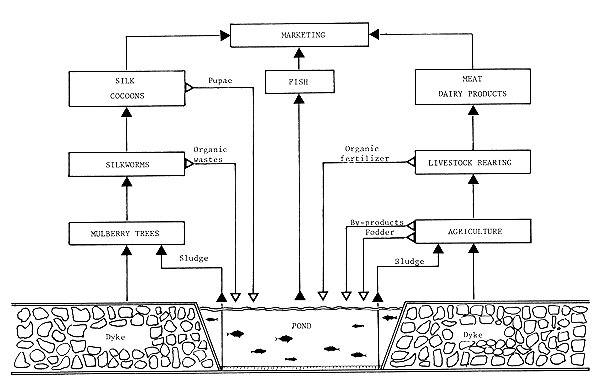
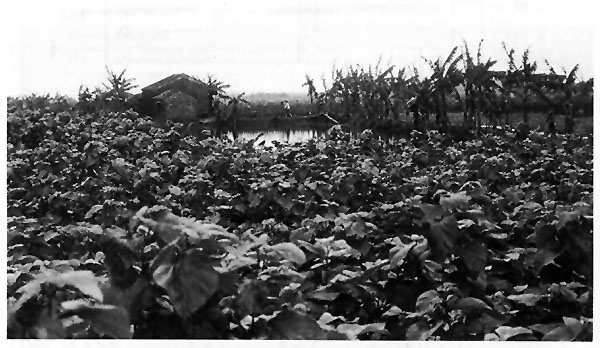
Figure 39 Integrated development at the Leliu People's Commune, Guangdong: fish ponds, piggery, bananas, mulberry, sugar cane, etc.

Figure 40 Use of pond dykes for the cultivation of mulberry and forest plants. ‘October’ Production Brigade, Xishui district, Hubei

Figure 41 Different crops right up to the water's edge. Leliu People's Commune, Guangdong
One of the main reasons for success is the adequate surface area allocated to fish culture, different major crops and livestock rearing. It has been suggested that the total surface area is broken down as follows: fish culture, 60%; livestock, 14%; fodder crops, 14%; food crops, 10% (ADCP, 1979). However, the type of crop preferred on the farm strongly influences fish yields and there too, a certain balance must be obtained. This is why, at the Leliu People's Commune (Guangdong), which specializes in fish culture, the annual yields of the ponds of the different production brigades varies between 1 500 and 7 500 kg/ha, depending on the proportion of the total area under mulberry as compared to the area under sugar cane. Fish yield is higher when this proportion is higher and when larger quantities of residue from silkworms are available for the ponds. According to the Leliu technicians, the ideal, balanced proportions should be in the vicinity of 50% for fish culture, 30%+ for sugar cane and 10%+ for mulberry.
Throughout the study tour, members obtained quantitative data from their Chinese hosts on the different types of production, as well as on the coefficients of conversion, normally used to plan the operation of fish farms, crop and livestock farming activities combined (Table 31). They have been worked out empirically after many years of practical experience and will have to be confirmed on a scientific basis in the future.
Finally, during normal periods, a relatively small number of specialized staff is used to manage the integrated farms. An average of one person to up-keep 6–8 ponds, each 0.33–0.47 ha, or 30–50 pigs or 500–1 000 poultry. Extra personnel is used only in periods of intense activity, e.g., at harvest time, stocking time or for marketing.
Table 31
Output and coefficients of conversion used when fish culture is integrated with crop and livestock farming
| A. | ANNUAL OUTPUT | |
| (a) | Plant Production | |
| - | Elephant grass (Pennisetum), Guangdong: 225 t/ha | |
| - | Aquatic plants: Lemna, Azolla, Wolffia, etc., Guangdong: 150–187 t/ha water hyacinth (Eichornia), Guangdong: 400–750 t/ha | |
| - | Sugar cane; leaves, Guangdong: 90 t/ha | |
| - | Mulberry; leaves, Guangdong: 135 kg/plant or 45 t/ha | |
| (b) | Production of Organic Fertilizers | |
| - | Pigs: 7.8–8 t/pig | |
| (Hele People's Commune: 6 pigs = 21 t in 5 months of piglet weighing 65 kg live weight) | ||
| - | Cows: 6–9 t/cow (Hele People's Commune = 21 t/cow) | |
| - | Ducks: Hele People's Commune, Jiangsu: 150 kg/duck | |
| (c) | Silt | |
| - | Rate of accumulation at Hele People's Commune, Jiangsu: 10 cm/year | |
| - | Pond production: 125–225 t/ha | |
| B. | CONVERSION TO INTEGRATED SYSTEM | |
| (a) | Plant Cultivation | |
| - | Aquatic plants: 1 ha can feed 150 pigs | |
| - | Land plants (residue): 1 ha can feed 15 pigs | |
| (b) | Fish Culture | |
| - | Land plants: 0.1 ha can feed 1 ha of pond | |
| - | Compost: 4 kg produce 1 kg of fish | |
| - | Silkworms: 1 ha of mulberry = 45 t of leaves = silk + 150 kg of fish 10–20 kg residue produce 1 kg of fish | |
| - | Pigs: 45–75 pigs/ha of pond (Hele People's Commune: optimum 90 pigs/ha) | |
| - | Fowls: 450 fowls/ha of pond | |
| - | Ducks: maximum 1 200–1 400 ducks/ha of pond | |
| - | Silt: 2 ha of pond allow 1 ha of crops to be fertilized | |
Tilapia farming is relatively new to China. Indeed, Sarotherodon mossambicus (syn. T. mossambica) was introduced for the first time in Viet Nam in 1957. Another species, S. niloticus, was introduced only a few years ago and the current trend is for it to replace S. mossambicus in fish farming.
The study group had the opportunity of seeing a tilapia farm at the Hele People's Commune (Jiangsu). S. mossambicus was introduced only in 1971 and S. niloticus only in 1978, on an experimental basis. The latter will be cultivated in ponds from 1980.
Since the winters are too cold, the brood fish and fry are raised from November to May in plastic green-houses, where the pond temperature does not fall below 17–20°C (Figure 42). Two 120-m2 earth ponds are stocked at the rates of 5 kg/m2 (brood fish) and 500 specimens/m2 (fry born in August/September). They are fed on rice bran, distributed every 2–3 days at the rate of 0.5 percent of the biomass. The brood fish spawn as soon as the water temperature reaches 20–22°C and it has been noted that a S. mossambicus female weighing 50 g, can produce an average of 350 fry/year.

Figure 42 Tilapias wintering under glass in earth ponds equipped with floating aerators, Hele People's Commune, Wuxi, Jiangsu
From May, tilapias are reared in well-fertilized ponds as a secondary polyculture species (Table 22). The average stocking rate with 5–7 g fry is 1.5 specimens/m2. They reach an average weight of between 50 and 70 g in 120 days of rearing. Three months later, females usually weigh more than 100 g and males, at least 250 g. Yields with S. mossambicus can reach 975–1 125 kg/ha in 4–5 months, respectively, without supplementary feeding and 1 875 kg/ha with feeding. Higher growth rates and yields should be possible with S. niloticus.
In the Guangdong province, polyculture of Chinese carps with S. mossambicus as the secondary species, is also done after sex distinction and sorting of the males (Anon., 1980). Since errors in sex distinction occur due to the small size of the fry (6–7.5 cm), all later spawning is controlled by means of predators (e.g., 450–600 snakeheads of between 3 and 3.6 cm in length/ha), which are stocked at the same time as the carps. The ponds are well fertilized. The low stocking density of male tilapias (0.3–0.45 specimens/ m2), combined with the warm climate, produces table fish of between 100 and 200 g each within 60–90 days. Since stocking takes place at the beginning of May and the end of July, two crops can be obtained in a year. Stocking density of tilapia cannot be increased without there being a risk of causing competition for food, not only with the main plankton feeders, but also with the detritus feeding mud carp.
Tilapia is sometimes cultivated as the main species in polyculture, particularly in very fertile waters which have been enriched with domestic waste water (Anon., 1980). In this case, stocking is done once a year with a mixture of big (30 g; density 0.15 specimens/m2) and small fingerlings (1.3 g; density 2.25–3 specimens/m2). This is followed by three harvest periods:
In an attempt to promote combined fish culture/crop/livestock farming, most fish farms are designed as part of communal farming systems. Farm layout will vary depending on the relative importance of fish culture as compared to the other activities.
For example, when the people's communes specializes in fish culture, the ponds are usually grouped together in a fish culture bloc and the dykes between ponds are relatively narrow (1.5–3.5 m at the top). On the other hand, when crop farming is the main activity, the ponds are dispersed among the crops which are cultivated on the dykes.
Depending on the relative importance of the fry trade, the proportion of the total surface area of the ponds earmarked for food-fish production can vary, e.g., between 45% (Leliu People's Commune, Guangdong) and 86.4% (‘October’ Production Brigade, Xishui district, Hubei). At the Hele People's Commune (Jiangsu), however, the technicians consider 70% to be the optimum proportion.
Water is supplied to the ponds through the crop irrigation network in the plains of the delta and the shallow waters. The water is raised by pumping and is discharged into the irrigation canals which supply both the cultivated fields and the ponds. Whenever possible, gravity feed is used, such as downstream from the Qingshan reservoir, Zhejiang (Section 7.2).
Use of electric pumps1 has spread, following the substantial progress made in rural electrification and because of the low cost of electrical energy (Hele People's Commune, Jiangsu: Y 0.06/kWh. Traditional devices for pumping water (e.g., the ‘dragon’ wheel) are nevertheless still used in some regions
The ponds cannot usually be emptied, and here again, the electric pump is used to drain them partially or totally to allow harvesting of the fish and cleaning and disinfecting of the pond. Total drainage is done once a year at the most. Many technicians prefer to keep the water in the ponds for two or even three years.
1 These are usually moveable, low output (1–3 m) pumps, with a flow rate of 2–4 m3 /min
Most fish ponds are made of earth. Sandy clay is said to offer the best conditions: it is watertight; decomposition of organic matter, fixing of fertilizers and preservation of mineral salts are good; aeration of the bottom is satisfactory.
When the new ponds at the Baitan Hu State Farm (Hubei) were visited, the study group discovered the enormous opportunities that existed for manual work (Figures 43 and 44). In the two consecutive winters, 1 500 000 m3 of earth were moved manually by 4 000 persons working 200 days. An average of 1 875 m3 of earth was dug and transferred per man-day. A bloc of 72 ponds, each 1.5 ha (55 × 270 m) were prepared over 133 ha of land.
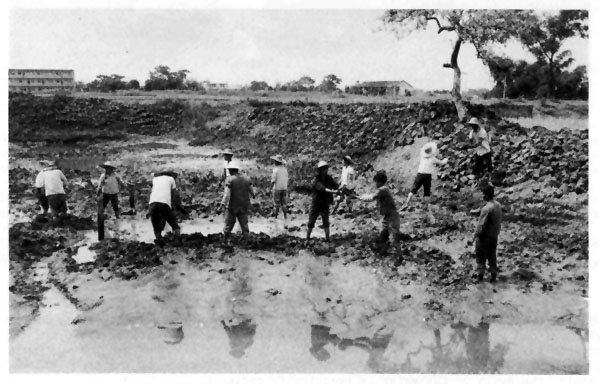
Figure 43 Manual construction of a fish pond (Photo F. Botts)
The dyke banks usually have a 1:1.5 to 1:2 slope. It may be gentle, to provide larger areas for crop cultivation. The width of the crown varies according to its use: as a pedestrian path (1.5–2 m), or for crops (10 m and over). As described in Section 6.3, the greater part of the dyke surface may be cultivated to produce the feedstruffs required for animal rearing, including fish culture.
The study group also visited cement ponds, which are used preferably for intensive fish culture (Section 7).
The surface areas of the growing ponds vary from 0.26 ha to more than 1 ha. However, earth ponds of 0.7 ha are preferred. Larger areas are chosen when the ground is less impermeable. The pond must be big enough to profit from the beneficial effects of the wind which mixes and oxidizes the water. On the other hand, too large ponds are difficult to manage and operate and the fish do not receive equal amounts of food (Anon., 1980).

Figure 44 Manual construction of a fish pond: cutting out, transferring and placing clods of earth (Photo F. Botts)
The depth of the water varies between 2 and 3 m, which ensures relatively stable temperatures and dissolved oxygen content, while providing the vertical space for the practice of polyculture with three feed levels. In colder climates and for mud carps in particular, slightly deeper ponds may be built. Since the slope of the pond bottoms is negligible, the depth of the water is practically constant.
The preferred shape of ponds is rectangular. The ratio of length to width is either 3:2, or 2:1. Old, irregularly shaped ponds (clay brick ventures, river bed, shallow) have for the most part been re-modelled and refitted, with a view to increased production. As far as intensive rearing in cement ponds is concerned, it was pointed out that oval ponds are preferred to round onces, since they allow droppings to be cleaned out more easily (Fish Culture Centre at Qingshan Reservoir, Zhejiang).
Positioning of the ponds is also important. Length wise, they should be in a north-south position, so that the pond gets maximum sunlight (winter heating, photosynthesis/ oxygenation). In some places, the direction of the prevailing winds is also taken into consideration. In this case, the length of the ponds is perpendicular to the direction of the winds in order to reduce erosion of the dykes due to too heavy waves (Hele People's Commune, Jiangsu).
The ponds are inspected daily and the following observations made:
The quality of the water (mainly oxygenation) can be improved by increasing the input flow of fresh water, by fertilizing the pond to increase phytoplankton concentration, by getting rid of planktonic micro-crustaceans (solution of trichlorfon, e.g., Dipterex, 1 500 kg/ha) and cyanophycean water flowers (solution of copper sulphate, 1.5–3 kg/ha) and by precipitating organic colloids in suspension (solution of alum, 22.5–45 kg/ha). The use of mechanical surface aeration is spreading rapidly, due to intensive rural electrification, the low cost of electricity and local manufacturing of paddle aerators (Section 14.1).
These two activities are governed and determined by the ‘four fixes’ and the ‘four observations’ (Section 6.2.3).
Very strict preventive measures against fish diseases are generally applied during rearing: control of weeds in the ponds, cleaning and disinfecting of ponds before stocking (see below), treatment of fry, sterilization of tools, disinfection of feeding areas.
However, certain diseases still occur. They are immediately treated according to therapeutic methods established experimentally. The main fish diseases and their treatment were briefly described to the study group when they visited the Hydrobiological Research Institute in Wuhan, Hubei (Section 4.1.3). More details are given in Chinese fish culture publications (e.g., Anon., 1980, p. 96–121).
After each complete harvest and before re-stocking, the fattening tank is cleaned (Section 6.6.5) and treated with chemicals. The main purposes of this treatment is to get rid of harmful organisms (e.g., predatory fish, frogs' eggs/tadpoles, aquatic insects, crabs, etc.), and to disinfect the pond by eliminating pathogenic organisms. The treatment is carried out either when the pond is almost completely empty or when it still contains a large amount of water (Figures 45 and 46). In the latter case, the doses take account of the depth of water. Depending on local availability, the three main products used are: quicklime, tea cakes and bleaching powder (Table 32).
Quicklime (CaO) is the most highly recommended, since it has side effects which are good for the quality of the water (Anon., 1980). Indeed, not only does it get rid of all harmful organisms (including thread-like spirogyra and young aquatic plants with superficial root systems), but also helps to:
Calcium is an essential nutrient for both plants and animals. In a pond which is almost empty, the limestone dose varies according to the quantity of organic silt present (Table 32).
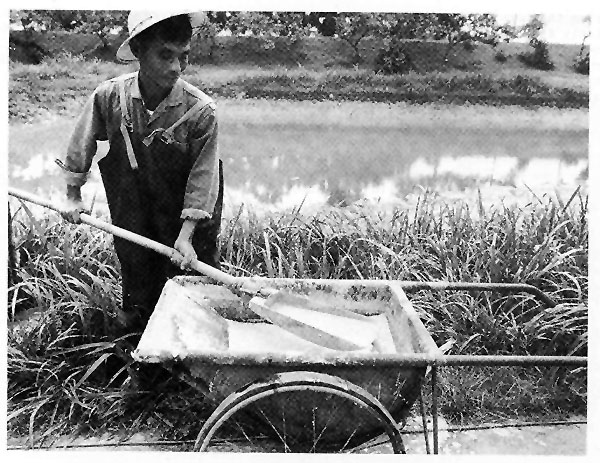
Figure 45 Applying quicklime to a small pond which has been partially drained. For large ponds, boats are used, as in Figure 46 (Photo F. Botts)
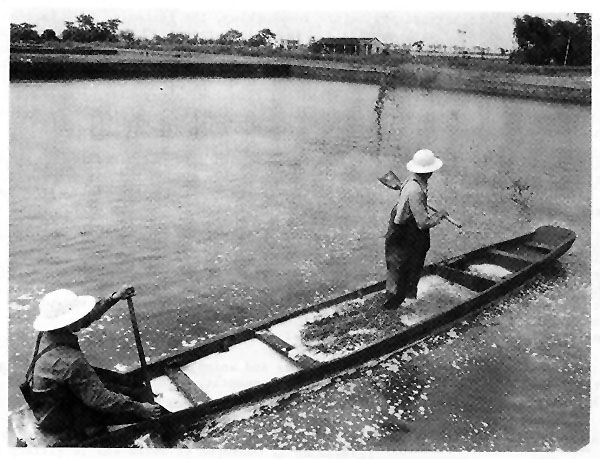
Figure 46 Treating a large pond with tea-seed cake from a boat (Photo F. Botts)
Table 32
Disinfection of fish ponds
(adapted from Anon., 1980)
| Product | Treatment | |||
| Water in pond | Dosea | Comments | ||
| 1. | Quicklime | 6–7 cm | 750–900 kg/ha | little silt at bottom |
| 6–7 cm | 900–1 125 kg/ha | silt at bottom of pond | ||
| considerable quantity | 1 875–2 250 kg/ha/m | |||
| 2. | Tea-seed cakes | considerable quantity | 525–675 kg/ha/m | 5–10 days prior to stocking |
| 3. | Tea-seed cakes and quicklime | considerable quantity | TC: 525–675 kg/ha/m | 5–10 days prior to stocking |
| QL: 100 kg/ha/m | ||||
| 4. | Bleaching powder | considerable quantity | 203 kg/ha/m | 5 days prior to stocking |
a kg/ha/m: kg/ha per metre of depth of water
Tea cakes are a by-product of oil production from oil-producing tea seeds, such as Camellia (C. sasangua, C. semiserrata and C. deifera). This cake contains 30 percent saponine, a deadly hemolytic toxin which, at a rate of 10 ppm, kills fish after 11 h of exposure (Anon., 1980). The higher the water temperature, the more quickly the toxic effect disappears, usually in 5–10 days. The tea-seed cake is ground up and soaked for 24 h in warm water (approximately 25°C). This solution is then diluted and distributed over the entire surface of the pond (Figure 46). Wild fish, frogs' eggs and tadpoles, small molluscs, leeches and some aquatic insects are thus got rid of.
The method usually preferred to the latter, consists of first treating the pond with tea-seed cakes (normal dose), and then applying quicklime, to improve the quality of the water (Table 32).
Bleaching powder, which contains approximately 30 percent active chlorine, has a strong oxydizing effect when mixed with water and this enables it to be used as a sterilizing agent. A solution is made up just before use and is immediately applied to the pond and distributed evenly throughout the body of water (mixing/stirring). The toxic effect is almost the same as that of quicklime, although it is less pronounced in fertile water. Toxicity disappears in five days.
At the end of the rearing period, the final harvest is done by hand, either by fishing with a seine net after having partially drained the pond, or by complete drainage (Figure 47).
Complete drainage of the pond is not considered except at fairly long intervals, usually between 1 and 3 years. The beneficial effects of an annual drainage lasting 15–20 days (checking vegetation, elimination of parasites, mineralization of the bottom) are nevertheless acknowledged by the Chinese technicians. However, whether it can be done, depends essentially on local constraints imposed by combined fish culture/crop/livestock farming and the utilization of available water.

Figure 47 Harvesting fish using a seine net (Photo F. Botts)
During rearing, the application of large quantities of organic fertilizers and plant feed encourages the build-up on the pond bottom of a layer of organic matter. At the Hele People's Commune (Jiangsu), the rate of build-up is approximately 10 cm per year. This silty deposit, which should not exceed 10–15 cm, helps to increase dissolved oxygen consumption and acidifies the lower levels of deep water. In order to prevent the quality of the water from being irreversibly damaged, a layer of silt is removed periodically (Figure 48) and used as organic fertilizer for crops which are cultivated in combination with fish culture (Section 6.3).